Yes, Right! Bonsai art for spiritual healing environments, indoor and outdoor spaces. Modern life often leaves you feeling stressed, restless, and disconnected from a sense of peace. You search for calm, but your room still feels heavy, and your mind won’t slow down. What if a single living work of art could shift that energy?
This is where bonsai (盆栽) comes in. More than just a tiny tree, bonsai is a practice that began in ancient China’s Tang Dynasty as Penjing (盆景) and blossomed in Japan’s Edo period, guided by Zen Buddhist mindfulness and Daoist harmony. Its very essence reflects wabi-sabi, the beauty of imperfection, and mono no aware, the gentle acceptance of life’s fleeting moments.
Each bonsai tells its own healing story. A pine whispers of longevity and strength, a Japanese maple (Acer palmatum) mirrors life’s constant changes, and a jade bonsai (Crassula ovata) invites prosperity and positive chi as taught in Feng Shui. Even the simple act of pruning or watering becomes a quiet meditation, helping you reconnect with balance and patience.
Across the world, places like Omiya Bonsai Village in Japan and the National Bonsai Foundation in the USA preserve this art form, showing that bonsai is not only cultural heritage but also a pathway to emotional balance, ecological awareness, and spiritual healing. If you’ve ever longed to turn your space into a sanctuary, bonsai offers you a way to begin.

What Does a Bonsai Symbolize in Spiritual Healing?
Every bonsai carries a story, and that story becomes part of your healing space. These tiny trees are more than plants, and they are living symbols that speak to your emotions, your energy, and your spirit.
A pine bonsai (Pinus) is one of the oldest symbols in Asian culture. In both Daoist philosophy and Zen tradition, it represents longevity, resilience, and unshakable strength, making it ideal for anyone seeking endurance in life’s struggles.
A Japanese maple (Acer palmatum) tells a softer story. With its fiery red leaves in autumn and fresh green in spring, it embodies change, transformation, and renewal. If you’re facing transitions or emotional growth, a maple bonsai reminds you that change can be beautiful.
The jade bonsai (Crassula ovata) is deeply linked to Feng Shui. Known as the “money tree”, it’s believed to attract prosperity, abundance, and positive chi. Placing one in a meditation room or near your home entrance aligns the energy of your environment with flow and success.
Even flowering bonsai, such as cherry blossom (sakura), symbolize hope, purity, and the fleeting beauty of life (mono no aware). Each bloom whispers the lesson of cherishing the present moment.
By choosing a bonsai species that speaks to your personal journey, you’re not just decorating. You’re inviting symbols of healing, renewal, and harmony into your daily space.
How Bonsai Contributes to Spiritual Healing?
A unique bonsai plant is a traditional living art of cultivating miniature trees, which can be a powerful tool for creating and enhancing spiritual healing environments. The practice of the bonsai, rooted in Zen Buddhism and Daoism, encourages mindfulness, inner peace, and a connection with nature, all of which can contribute to a more restorative and healing atmosphere.
- Mindfulness and Meditation: The meticulous care required for bonsai, including pruning, shaping, and watering, fosters a meditative state and promotes focus on the present moment. This mindful engagement can help individuals release stress, quiet the mind, and cultivate inner peace.
- Connection with Nature: Bonsai brings the essence of the natural world indoors, offering a tangible link to the cycles of growth, decay, and renewal. This connection can be particularly beneficial for those seeking to reconnect with nature or who live in urban environments.
- Symbolism and Metaphor: Bonsai trees can symbolize resilience, adaptability, and the beauty of imperfection. Their ability to thrive in a confined space can be a powerful metaphor for human growth and overcoming adversity.
- Therapeutic Applications: Studies have explored the therapeutic benefits of bonsai, particularly in group settings, where it can foster social interaction, emotional expression, and a sense of community.
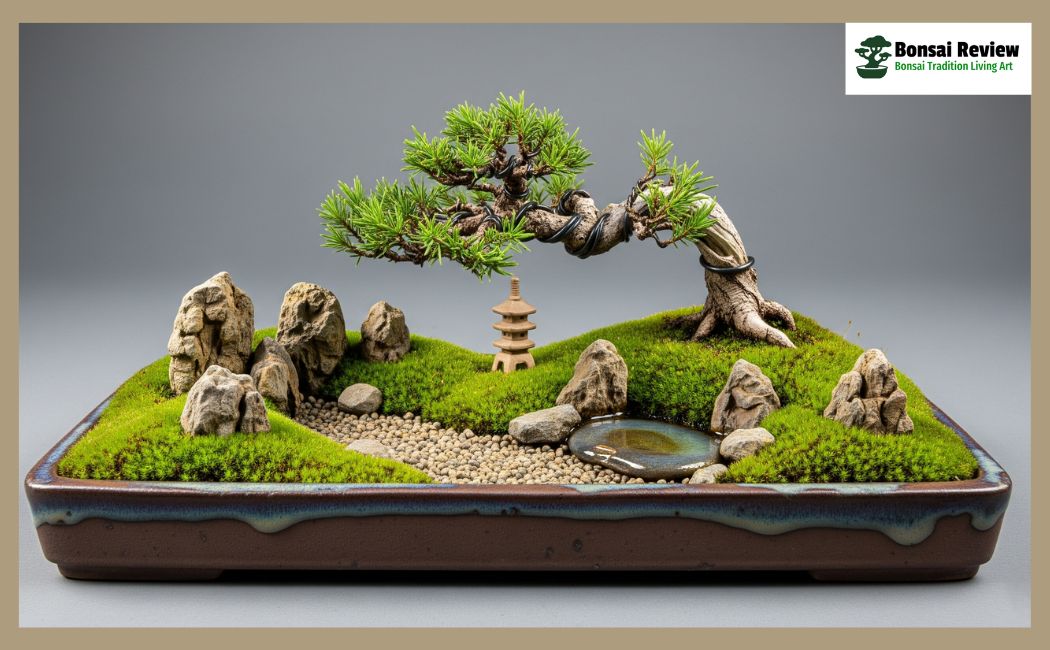
Creating Healing Spaces with Bonsai:
- Dedicated Meditation Spaces: Integrating bonsai trees into meditation corners or altars can enhance the spiritual ambiance and deepen the meditative experience.
- Restorative Environments: Placing bonsai in waiting rooms, therapy spaces, or other areas where individuals seek respite can promote a sense of calm and well-being.
- Symbolic Gardens: Bonsai can be incorporated into larger garden designs, creating symbolic landscapes that reflect personal growth, healing journeys, or spiritual aspirations.
- Air Purifying Indoor Room: Some dwarf plants really can clean the air. NASA tested the Clean Air Study on how indoor plants affect air quality. Scientists wanted to know if plants could remove bad chemicals from closed rooms. Money plant jade bonsai (Crassula ovata), Snake plant, ZZ tiny plant, etc.
In essence, bonsai living art, with its blend of aesthetics and spiritual depth, offers a unique and accessible pathway to cultivate healing and well-being in various environments.
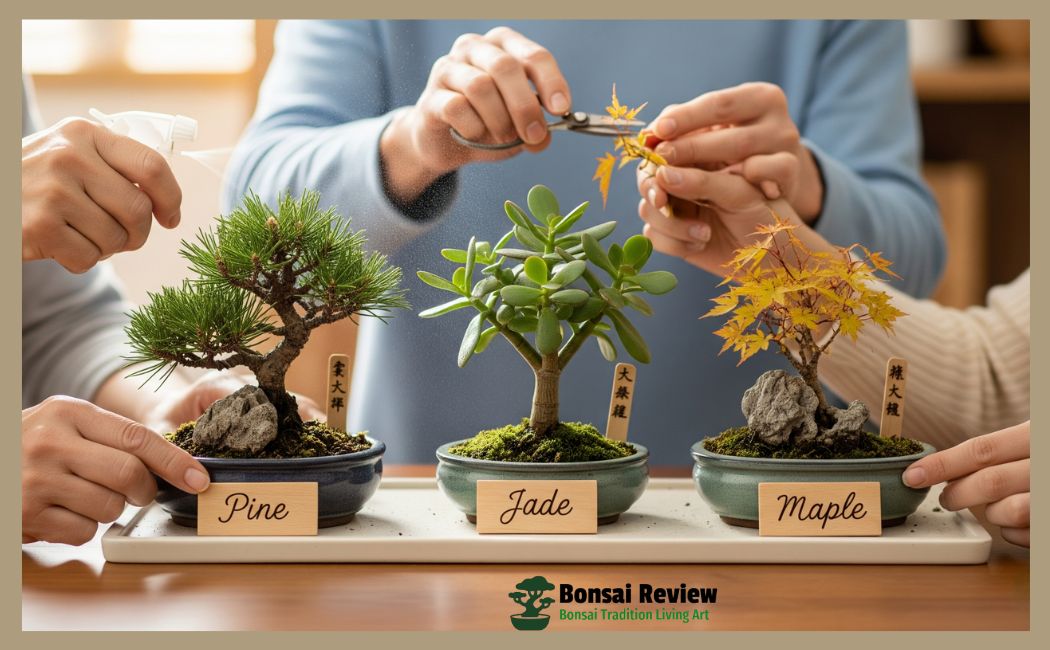
What Role Does Caring for Bonsai Play in Spiritual Healing?
Owning a bonsai is not just about placing it in your room; the true healing begins when you care for it with your own hands. Every task, from pruning to watering, becomes a mindful ritual that strengthens your spirit.
When you prune branches or pinch leaves, you practice the art of letting go. This mirrors life’s lessons: you release what no longer serves you, so new growth can emerge. In Zen practice, this act is seen as purification of the mind.
Watering is another meditative moment. As the water flows into the soil, you are reminded of nourishment, patience, and steady balance. In Feng Shui, this simple act also refreshes the chi energy in your space.
Even wiring and shaping branches have a symbolic role. You guide the tree gently, never forcing, showing the same compassion and patience you wish to give yourself. This aligns with the spirit of Daoist philosophy, where harmony comes not from control, but from gentle direction.
Over time, caring for your bonsai builds mindfulness, resilience, and inner calm. Instead of being a chore, it becomes a living meditation.
Many practitioners even describe bonsai care as a form of nature therapy, where your thoughts slow down, your breathing deepens, and your spirit feels lighter.
By nurturing the dwarf tree, you are, in truth, nurturing yourself.

How Can Bonsai Transform Your Space into a Healing Sanctuary?
When stress lingers in your room, it’s often the energy of the space that feels heavy. Bonsai can shift that energy, turning an ordinary corner into a place of calm, balance, and reflection.
In Feng Shui practice, placing a bonsai in the right spot allows positive chi (life energy) to flow. A jade bonsai by the entrance welcomes abundance, while a pine or maple bonsai in a meditation room supports endurance and emotional clarity. Each tree becomes a living energy anchor.
In a yoga studio or meditation corner, a bonsai works as a visual focus for mindfulness. As you breathe and stretch, your eyes rest on the miniature tree, grounding your thoughts in the present moment. This practice reflects the Zen Buddhist approach of finding serenity through nature.
Even in modern design, bonsai connects you to the wabi-sabi aesthetic, one of simplicity, imperfection, and natural flow. A single bonsai on a low wooden table can soften an urban apartment, inviting the quiet elegance (shibui) that your mind craves after a noisy day.
Healing environments are not only about silence, but about relationships with living things. Watering, pruning, and caring for your bonsai becomes a ritual one that clears negative energy and replaces it with patience, balance, and inner peace.
With just one tree, you can transform your environment into a sanctuary of stillness, a space where stress melts and your spirit feels at home.
Which Bonsai Species Are Best for Healing Spaces?
Not every bonsai feels the same in a healing space. Each species carries its symbolism, energy, and spiritual meaning. Choosing the right one helps align your bonsai with your personal journey. Here’s a quick practice or guide:
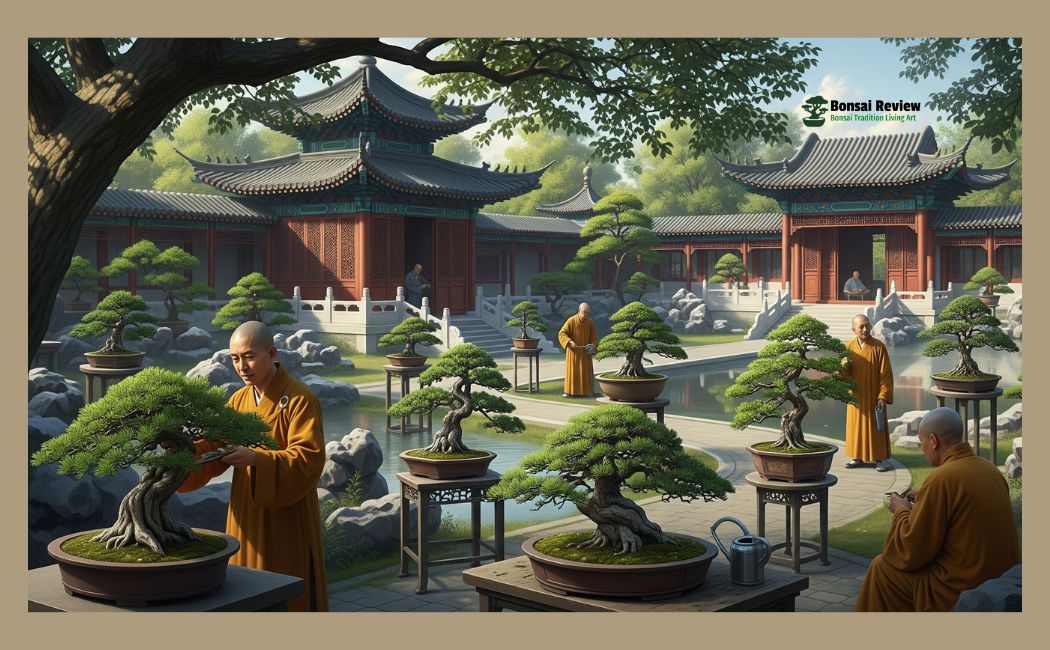
| Bonsai Species | Spiritual Meaning | Best For Healing | Tradition/Philosophy Linked |
| Pine Bonsai (Pinus) | Longevity, resilience, strength | Building endurance during struggles | Daoist, Zen |
| Japanese Maple (Acer) | Change, renewal, transformation | Emotional growth, adapting to life transitions | Japanese aesthetics (wabi-sabi) |
| Jade Bonsai (Crassula) | Prosperity, abundance, positive energy (chi) | Attracting wealth and balance in home/work | Feng Shui |
| Cherry Blossom (Sakura) | Hope, purity, beauty of life’s fleeting moments | Living in the present, appreciating small joys | Mono no aware, Zen |
| Ficus Bonsai | Adaptability, harmony, protection | Reducing stress in busy homes or offices | Common in meditation spaces |
| Juniper Bonsai | Purification, protection, spiritual cleansing | Clearing negative energy and promoting clarity | Shinto and Zen traditions |
By understanding what each tree symbolizes, you can pick a bonsai that doesn’t just look beautiful, and it mirrors your healing journey and strengthens your environment’s energy.

Where Should You Place Bonsai for Maximum Healing Energy?
Placing your bonsai in the right spot is just as important as choosing the right species. The location influences chi, mood, and mindfulness, transforming ordinary spaces into sanctuaries of calm.
- Meditation Corners & Yoga Spaces: Position a pine or maple bonsai where you can see it while meditating. Its presence supports patience, focus, and emotional balance, aligning your practice with Zen mindfulness.
- Home Entrance or Office Desk: A jade bonsai near the doorway invites positive energy, prosperity, and abundance into your daily life. Feng Shui recommends keeping it healthy and vibrant to enhance chi flow.
- Living Room or Common Areas: Flowering bonsai, like cherry blossoms, remind you and your guests to pause and appreciate life’s small joys. Their colors and blooms naturally uplift the room’s energy.
- Quiet Nooks or Shelves: Smaller bonsai, such as juniper or Ficus, work beautifully on low shelves or windowsills. Their presence fosters a subtle harmony and encourages mindfulness, even during busy days.
Bonsai, the art of cultivating miniature trees, can be a powerful tool for creating and enhancing spiritual healing environments. The practice of bonsai, rooted in Zen Buddhism and Daoism, encourages mindfulness, inner peace, and a connection with nature, all of which can contribute to a more restorative and healing atmosphere.
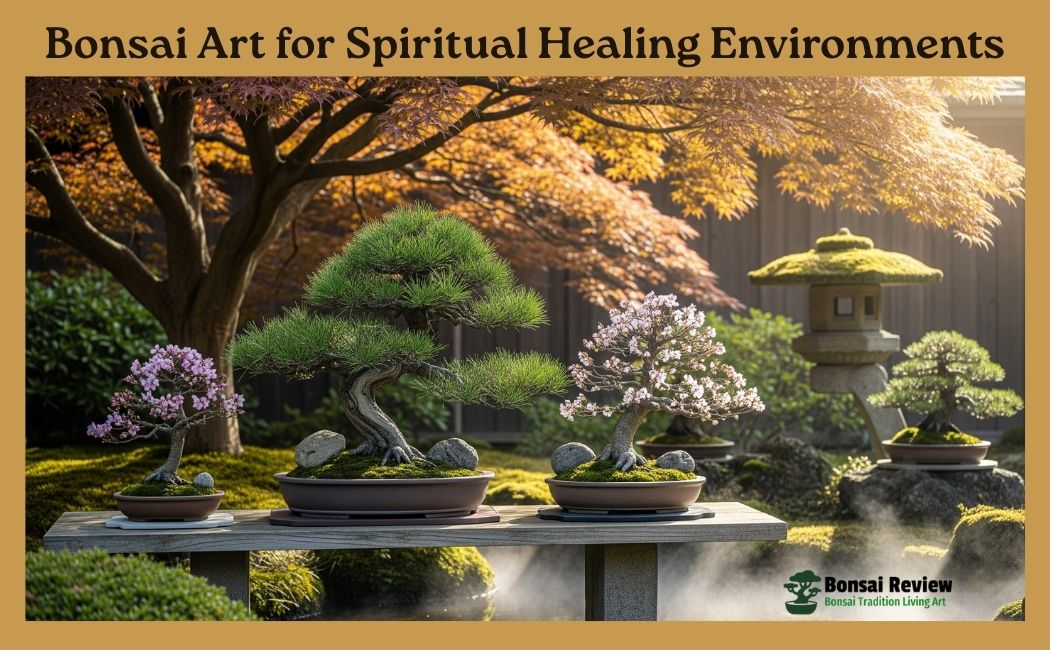
Other Tips for Placement: Bonsai Art for Spiritual Healing Environments.
- Avoid direct harsh sunlight for delicate bonsai; moderate natural light supports vitality.
- Keep the air around the bonsai fresh and uncluttered, allowing energy to circulate freely.
- Rotate the bonsai occasionally so every side receives balanced attention and light, symbolizing fairness and flow in your life.
By intentionally placing bonsai in spaces where you live, work, and reflect, you activate its full healing potential, making your environment a daily sanctuary of mindfulness, balance, and spiritual calm.
What Daily Rituals with Bonsai Enhance Spiritual Healing?
Healing with bonsai isn’t just about owning a dwarf tree, and it’s about creating daily moments of mindfulness, reflection, and connection. Small, intentional actions can transform your life and your space.
1. Morning Reflection: Bonsai Art for Spiritual Healing Environments.
Start your day by observing your bonsai. Notice the shape of its branches, the color of its leaves, and its overall energy. This short practice cultivates presence and awareness, grounding you before the day begins.
2. Watering with Intention
Water your bonsai slowly and mindfully. As you pour, imagine nourishing both the tree and your spirit. Each drop represents patience, balance, and the flow of positive energy (chi) through your environment.
3. Pruning as Letting Go with Bonsai Art for Spiritual Healing Environments.
When you prune dead or excess branches, think of it as releasing mental clutter and old habits. Bonsai pruning mirrors life lessons in patience, focus, and acceptance, central to Zen and Daoist practices.
4. Meditation Companion
Use your bonsai as a visual anchor during meditation or yoga. Its miniature natural scene helps you focus, slow your thoughts, and find harmony with nature. A pine or maple bonsai is particularly grounding in these practices.
5. Evening Gratitude with Bonsai Art for Spiritual Healing Environments.
Before bed, take a moment to express gratitude to your bonsai. Acknowledge the vitality it brings to your space and the calm it fosters in your mind. This simple ritual reinforces mindfulness, patience, and emotional healing.
Over time, these rituals turn bonsai care into living meditation. Each interaction nurtures inner peace, spiritual clarity, and a deeper connection to nature. Your bonsai becomes more than a decoration, and it becomes a daily practice of healing and growth.
Which Famous Bonsai Collections Inspire Spiritual Healing?
Bonsai Art for Spiritual Healing Environments: Seeing how masters cultivate bonsai can help you connect with the practice on a deeper level. These collections demonstrate discipline, patience, and aesthetic balance, all essential for spiritual and emotional healing.

1. Omiya Bonsai Village, Japan
Located in Saitama, Japan, this village is often called the “Bonsai Mecca”. It features centuries-old pines, maples, and junipers. Walking through these gardens, visitors experience tranquil energy, harmony with nature, and meditative calm, making it a living example of how bonsai supports spiritual mindfulness.
2. Obuse Kokufu Bonsai Museum, Japan
This museum preserves historical bonsai specimens dating back hundreds of years. Each tree reflects the aesthetic principles of wabi-sabi and embodies longevity, resilience, and inner balance, showing how bonsai can serve as a daily source of inspiration for healing spaces.
3. Crespi Bonsai Museum, Italy
Home to rare species like Taiwanese junipers, Crespi demonstrates how bonsai appreciation has spread globally. The museum emphasizes care, patience, and cultural connection, illustrating that spiritual healing through bonsai transcends geography.
4. Private Collections by Contemporary Masters
Modern bonsai masters such as Itō and Tokugyoku continue ancient traditions while integrating Zen meditation practices. Their collections often include named bonsai specimens like Chabo Hiba or Ryunoken, celebrated for their balance, vitality, and almost spiritual presence. Observing or learning from these masters inspires you to bring mindfulness and patience into your daily practice.

Takeaway for Your Healing Space: Bonsai Art for Spiritual Healing Environments.
- Draw inspiration from these collections to curate your bonsai sanctuary.
- Notice how tree selection, placement, and care rituals contribute to calm, focus, and spiritual renewal.
- Even one bonsai in your room can mirror the tranquility and discipline of these world-renowned collections.
How Can You Sustain Your Healing Bonsai Practice for Long-Term Benefits?
A bonsai’s spiritual and healing impact grows stronger over time, but only if you care for it consistently and mindfully. Here’s how to maintain your bonsai and your connection with it:
1. Consistent Daily Attention for Bonsai Art for Spiritual Healing Environments.
- Water, prune, and observe your bonsai daily.
- Even a few minutes each day cultivates mindfulness, patience, and emotional grounding.
- Notice small changes, new buds, leaf growth, or branch adjustments as reminders of life’s constant growth and transformation.
2. Seasonal Adjustments with Bonsai Art for Spiritual Healing Environments.
- Bonsai requires attention to sunlight, temperature, and humidity through different seasons.
- For example, a maple bonsai may need more shade in summer and protection in winter.
- Adjusting care according to the season reflects the Daoist principle of harmony with natural cycles.
3. Advanced Care Techniques with Bonsai Art for Spiritual Healing Environments.
- Use techniques like wiring, grafting, and shaping to enhance the tree’s aesthetic balance and spiritual presence.
- These practices deepen your engagement, teaching discipline, focus, and reverence for life.
4. Meditative Integration:
- Incorporate bonsai into daily meditation, yoga, or reflection sessions.
- Treat each interaction as a mindful ritual, reinforcing inner calm, balance, and emotional healing.
5. Long-Term Spiritual Connection:
- Over months and years, your bonsai becomes a living witness to your personal growth.
- Its miniature landscape mirrors your spiritual journey, reminding you of patience, resilience, and harmony with nature.
By following these tips, your bonsai becomes more than a plant, and it transforms into a lifelong companion for healing, mindfulness, and spiritual growth.
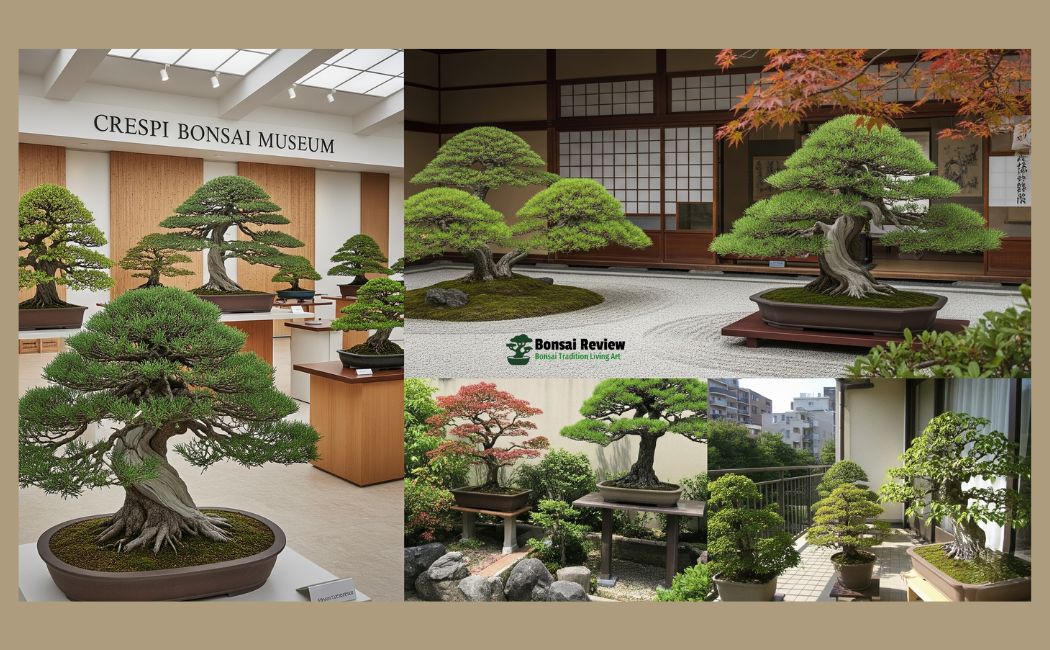
Conclusion: Transform Your Space and Spirit with Bonsai.
Bonsai is more than a miniature tree, and it is a living bridge between nature, mindfulness, and spiritual healing. From its origins in ancient China and Japan, bonsai has carried lessons in patience, discipline, and harmony, allowing practitioners to experience inner calm and emotional balance through daily care.
By choosing the right species, such as pine, maple, jade, cherry blossom, or ficus bonsai, you can place them thoughtfully in your home or meditation space.
And by practicing mindful rituals like watering, pruning, and meditation, you can transform ordinary rooms into sanctuaries of serenity.
If you are a beginner or inspired by world-renowned bonsai collections, integrating bonsai into your life cultivates long-term spiritual growth, emotional clarity, and a deeper connection to nature.
Every branch, leaf, and carefully shaped curve is a reminder that true healing comes from patience, awareness, and reverence for life, making bonsai a timeless companion for your journey toward inner peace.
Helpful article: How to Choose the Best Bonsai for Meditation and Stress Relief?
FAQs: How Can Bonsai Trees Improve Your Mental and Spiritual Well-Being?
1. Can any bonsai bring spiritual healing?
Yes, most bonsai species can support mindfulness, emotional balance, and calm. However, certain trees like pine, maple, jade, or cherry blossom bonsai carry specific spiritual meanings that can enhance healing more intentionally.
2. How often should I care for my bonsai to benefit spiritually?
Daily attention is ideal. Simple acts like watering, pruning, and observing help cultivate mindfulness, patience, and inner peace. Even 5–10 minutes a day can have a significant calming effect.
3. Does placement affect a bonsai’s healing energy?
Absolutely. Bonsai should be placed in areas where you meditate, work, or relax. According to Feng Shui, species like jade bonsai near entrances promote positive energy, while pine or maple bonsai in meditation spaces enhance focus and tranquility.
4. Can bonsai help with stress or anxiety?
Yes. Caring for bonsai is a form of nature therapy. Activities like pruning, watering, and shaping encourage slow, mindful movements, helping to reduce stress, center thoughts, and improve emotional well-being.
5. Which bonsai species are best for beginners seeking spiritual benefits?
Ficus Bonsai is resilient and forgiving, making it an ideal choice for indoor meditation spaces. Jade Bonsai symbolizes abundance and positive energy. Juniper Bonsai promotes clarity and air purification. These species are easy to care for and provide strong symbolic support for healing.
6. How long does it take to feel the spiritual benefits of bonsai?
Benefits can begin immediately with mindfulness practices, like observing or watering your bonsai. A deeper spiritual connection develops over weeks to months, as you cultivate discipline, patience, and harmony with the tree.
7. Can bonsai be used in meditation or yoga practices?
Yes. Using a bonsai as a visual anchor during meditation or yoga enhances focus, mindfulness, and emotional calm. Pine and maple bonsai are particularly grounding for these practices.
8. Are Bonsai Trees Therapeutic?
The therapeutic effects of bonsai tree care on mental health are profound, offering a unique blend of tranquility and mindfulness. This engaging interaction with nature transcends traditional stress-relief methods, serving as a mental sanctuary.
9. Is Bonsai Good Energy?
In Feng Shui, the ancient Chinese art of harmonizing energies in the environment, bonsai trees are believed to attract positive chi (energy) and promote balance. Placing a bonsai in specific areas of the home or workspace is thought to bring good luck, wealth, and prosperity.
10. What are the Disadvantages of a Bonsai Tree?
Keeping a Bonsai Tree inside the house may not be favorable for your pets, as it is toxic to both cats and dogs. Ingesting Bonsai can cause respiratory problems in pets. Mite infestation and other insects can easily harm Bonsai, so it is beneficial to keep them at home.